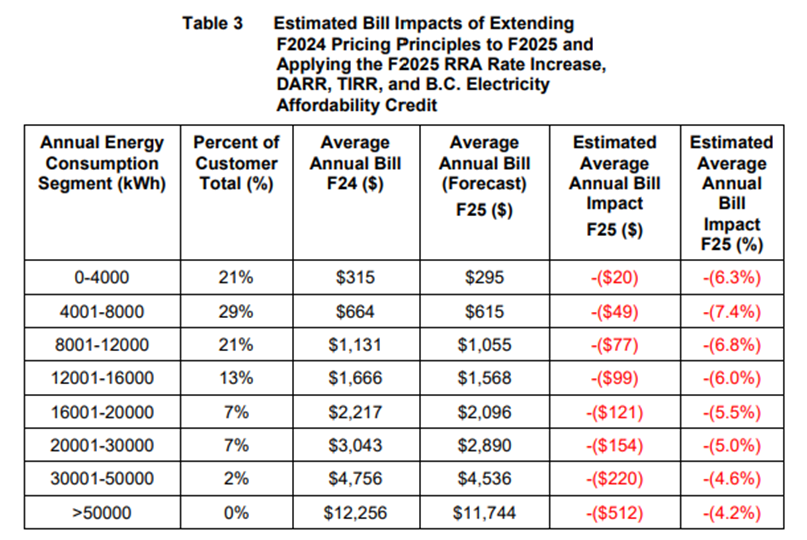On March 8, 2024, the BCUC approved BC Hydro’s request to finalize rates for its residential customers in fiscal year 2025, beginning April 1, 2024.
This article explains the decision; read this article to examine the process the BCUC used to arrive at this decision.
BC Hydro’s residential customers pay a fixed basic charge and a variable two-tiered inclining block rate based on their consumption. Customers pay the Step 1 rate for electricity until they reach a threshold of 1,350 kWh per bi-monthly billing period, after which they pay the Step 2 rate.
The threshold of 1,350 kWh bi-monthly, approved in 2008, is set to be 90 percent of the median usage for BC Hydro’s residential customers, although BC Hydro noted in 2023 that approximately 75 percent of its residential customers have consumption “above the step 1 / step 2 threshold in one or more billing periods per year.”
The BCUC approved a general rate increase of 6.42 percent for BC Hydro rates in its fiscal 2023 to 2025 revenue requirements application decision, issued in April 2023. In this latest decision, the BCUC approved BC Hydro’s request to allocate that general rate increase of 6.42 percent between the basic rate, Step 1 rate and Step 2 rate as follows:
| Fiscal 2024 rate | Fiscal 2025 rate | Increase | |
| Basic rate (cents per day) | 21.17 | 22.53 | 6.42 percent |
| Step 1 rate (cents per kWh) | 9.75 | 10.97 | 12.51 percent |
| Step 2 rate (cents per kWh) | 14.08 | 14.08 | No change |
BC Hydro is financially indifferent to this allocation, because it gives the utility the same revenue as if it had increased each of the three components by 6.42 percent.
Despite the majority of its residential customers paying only or primarily the Step 1 rate, BC Hydro forecasts that no residential customer will experience a bill increase. In fact, some will experience a bill decrease of as much as 7.4 percent. How can this be?
The government recently announced a “one-time BC Electricity Affordability Credit” that will help “reduce electricity bills for people and businesses in the coming year.” BC Hydro states this will be “a consumption-based credit averaging $100 to each BC Hydro Residential customer, to be applied in installments on bills issued for service in fiscal 2025”.
Two adjustments to BC Hydro’s residential customers’ bills will further mitigate the increase in the Step 1 rate.
The Deferral Account Rate Rider (or DARR) is the mechanism BC Hydro uses to collect or repay monies it previously under- or over-paid to customers. These under- or over-payments arise because BC Hydro sets its rates based on forecast demand and cost of energy, then collects in future years any differences between the forecast and what actually transpired. BC Hydro estimates the Deferral Account Rate Rider will reduce customers’ bills by 2.5 percent in fiscal 2025.
BC Hydro uses the Trade Income Rate Rider (or TIRR) to distribute to ratepayers the net income from Powerex, its non-regulated energy trading subsidiary (the government directed the BCUC to allow BC Hydro to subtract any profits made by Powerex from the costs it needs to recover from ratepayers). BC Hydro estimates the Trade Income Rate Rider will reduce customers’ bills by 10.0 percent in fiscal 2025.
The combined effect of these three mitigating factors is a bill reduction for each of BC Hydro’s residential customer segments:

Analysis
BC Hydro’s general rate increase of 6.42 percent for fiscal 2024 was more than twice the rate of inflation (Stats Canada reports that inflation in BC in January 2024 was 3.0 percent), and the increase in BC Hydro’s Step 1 rate was 12.51 percent. BC Hydro’s residential customers were spared the effects of the increase this time around thanks to the three mitigating factors described above, but there is no guarantee that these will continue.
The government already announced that its “BC Electricity Affordability Credit” is a one-time event, so there is no guarantee this exercise will be repeated (although to be fair, the government did the same thing in November 2022, the same day the new premier took office).
The Deferral Account Rate Rider, which reduced fiscal 2025 bills by 2.5 percent, is not always a refund. In fact, BC Hydro already estimates the Deferral Account Rate Rider will flip from a refund of 2.5 percent to a charge of 5 percent by fiscal 2026.
The Trade Income Rate Rider, which reduced bills by 10.0 percent in fiscal 2025, is dependent on Powerex continuing to be profitable. As we noted previously, there are significant risks to Powerex’s ability to export BC Hydro’s electricity if BC’s weather does not co-operate, and BC Hydro’s storage basins do not return to more normal levels.
The BCUC recently approved a Rate Smoothing Regulatory Account to keep BC Hydro’s annual bill increases for residential customers to 2.3 percent from fiscal 2026 to fiscal 2029. This depends, however, on Powerex continuing to deliver profits and BC Hydro keeping its annual rate increases under control.
BC Hydro’s forecast rate increases in fiscal years 2027 to 2029 are quite moderate (1.3, 3.5 and 2.4 percent respectively), following the 8.3 percent annual rate increase forecast for fiscal 2026, largely due to Site C coming online. But the final costs of Site C are not yet known, and BC Hydro’s forecasts do not include the cost of the $36 billion in new capital that the government recently announced would be spent on new infrastructure over the next ten years.
While the government is doing its best to keep BC Hydro’s bill increases under control, there are risks that are simply beyond its control.


